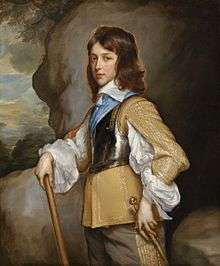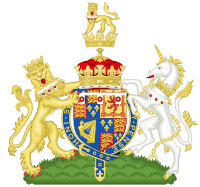Henry Stuart, Duke of Gloucester
| Henry Stuart | |
|---|---|
| Duke of Gloucester | |
 Prince Henry, c. 1653, by Adriaen Hanneman | |
| Born |
8 July 1640 Oatlands Palace, Surrey[1] |
| Died |
13 September 1660 (aged 20) Palace of Whitehall, London[1] |
| Burial |
21 September 1660 Westminster Abbey, London[2] |
| House | Stuart |
| Father | Charles I |
| Mother | Henrietta Maria of France |
Henry Stuart, Duke of Gloucester (8 July 1640 – 13 September 1660)[lower-alpha 1] was the youngest son of Charles I and his wife, Henrietta Maria of France, the third son to survive to adulthood (his eldest brother, Charles, Duke of Cornwall and of Rothesay was born and died the same day). He is also known as Henry of Oatlands.
Potential heir
After his father's defeat at the end of the English Civil War, Henry (unlike his older brothers, who escaped with their mother to France) was captured and brought to London. His captivity was largely shared by his elder sister Elizabeth. He was lodged in the royal apartments in the White Tower of the Tower of London, under the "protection" of the Republican army. During the debates among Republican army leaders Oliver Cromwell and Henry Ireton about what kind of regime should succeed the now abolished rule of Charles I, it was briefly suggested that the young prince might be placed on the throne, and made to govern as the kind of limited, constitutional monarch that Parliament wanted. Part of the motivation for this came from the perception that, unlike his brothers Charles and James, he was sufficiently young to have not yet been "corrupted" by the Catholic and absolutist views of his mother and father, and might be brought up by tutors who shared the Parliamentary perspective. However, this option quickly faded away, as the Rump Parliament opted instead for the establishment of a Republican Commonwealth. Henry was moved to more comfortable surroundings and allowed to live with relative freedom under the eyes of his Parliamentary guardians.
He and his sister were permitted to visit their father on the eve of his execution in January 1649. Elizabeth was then thirteen and Henry was eight. Elizabeth later wrote a wrenching account of the meeting which was found among her possessions when she died in September 1650:
| “ | He bid us tell my mother that his thoughts had never strayed from her, and that his love would be the same to the last. Withal, he commanded me and my brother to be obedient to her; and bid me send his blessing to the rest of my brothers and sisters, with communications to all his friends. Then, taking my brother Gloucester on his knee, he said, 'Sweetheart, now they will cut off thy father's head.' And Gloucester looking very intently upon him, he said again, "Heed, my child, what I say: they will cut off my head and perhaps make thee a king. But mark what I say. Thou must not be a king as long as thy brothers Charles and James do live; for they will cut off your brothers' heads when they can catch them, and cut off thy head too at the last, and therefore I charge you, do not be made a king by them.' At which my brother sighed deeply, and made answer: 'I will be torn in pieces first!' And these words, coming so unexpectedly from so young a child, rejoiced my father exceedingly. And his majesty spoke to him of the welfare of his soul, and to keep his religion, commanding him to fear God, and He would provide for him. Further, he commanded us all to forgive those people, but never to trust them; for they had been most false to him and those that gave them power, and he feared also to their own souls. And he desired me not to grieve for him, for he should die a martyr, and that he doubted not the Lord would settle his throne upon his son, and that we all should be happier than we could have expected to have been if he had lived; with many other things which at present I cannot remember.[3] | ” |
Paris
| Scottish and English Royalty |
| House of Stuart |
|---|
.svg.png) |
| Charles I |
Eventually, in 1652, Oliver Cromwell agreed to release Henry, and he travelled to join his mother and brothers in Paris. However, at least some of the influences that Cromwell had hoped to exert appeared to have been successful, as Henry had become a staunch Protestant, and quarrelled bitterly with his mother over matters of religion and politics. Their dislike for one another reached such a level that Henrietta virtually expelled him from Paris, and he went to join the Spanish armies fighting at Dunkirk. He consistently distinguished himself in battle, and gradually gained a reputation as one of Europe's foremost Protestant soldiers. It was during the course of the campaign that he met the renegade French military commander the Prince of Condé, who was leading the Spanish forces. Their common dislike for the Roman Catholic Church (Condé was an agnostic and one of the leading defenders of the Huguenots), created a strong bond between them. Shortly before his death, it was suggested that Henry might marry Condé's niece.
Restoration
After the conclusion of peace between France and Spain, Henry resided at one of Condé's estates, until the death of Oliver Cromwell and the gradual collapse of the Commonwealth led to calls for the restoration of the monarchy, and he was reunited with Charles. He returned to England as part of Charles' triumphant progress through London in May 1660, and took up residence in Whitehall.
Later life
He was created Duke of Gloucester and Earl of Cambridge by Charles II, but died suddenly of smallpox not long afterwards, much to his brother's distress. Decades later, during the exclusion crisis, Henry was looked back on as a kind of 'lost leader'; as what might have been a legitimate, warlike, Protestant alternative to the equally unpalatable choices of the Dukes of York (later James II) and Monmouth (James Scott).
He was buried in the south side of the Henry VII Chapel, Westminster Abbey, on 21 September 1660.[2]
Titles, styles, honours and arms

Titles
- 13 May 1659 – 13 September 1660: The Duke of Gloucester
Though it is said that he was created Duke of Gloucester and Earl of Cambridge on 13 May 1659, he was probably styled as such from birth.[1] He is styled the Duke of Gloucester in a letter directed to Theobald Lord Taaffe in 1642/3.
Honours
- KG: Knight of the Garter, 4 April 1653[1]
Arms
Henry's arms were those of the kingdom, differenced by a label argent of three points, on each a rose gules.[4]
Ancestors
| Ancestors of Henry Stuart, Duke of Gloucester | |||||||||||||||||||||||||||||||||||||||||||||||||||||||||||||||||||||||||||||||||||||||||||||||||||||||||||||||||||||||||||||||||||||||||||||||||||||||||||||||||||||||||||||||||||||||||||||||||||||||||||||||||||||||||||||||||||||||||||||||||||||
|---|---|---|---|---|---|---|---|---|---|---|---|---|---|---|---|---|---|---|---|---|---|---|---|---|---|---|---|---|---|---|---|---|---|---|---|---|---|---|---|---|---|---|---|---|---|---|---|---|---|---|---|---|---|---|---|---|---|---|---|---|---|---|---|---|---|---|---|---|---|---|---|---|---|---|---|---|---|---|---|---|---|---|---|---|---|---|---|---|---|---|---|---|---|---|---|---|---|---|---|---|---|---|---|---|---|---|---|---|---|---|---|---|---|---|---|---|---|---|---|---|---|---|---|---|---|---|---|---|---|---|---|---|---|---|---|---|---|---|---|---|---|---|---|---|---|---|---|---|---|---|---|---|---|---|---|---|---|---|---|---|---|---|---|---|---|---|---|---|---|---|---|---|---|---|---|---|---|---|---|---|---|---|---|---|---|---|---|---|---|---|---|---|---|---|---|---|---|---|---|---|---|---|---|---|---|---|---|---|---|---|---|---|---|---|---|---|---|---|---|---|---|---|---|---|---|---|---|---|---|---|---|---|---|---|---|---|---|---|---|---|---|---|---|---|---|
| |||||||||||||||||||||||||||||||||||||||||||||||||||||||||||||||||||||||||||||||||||||||||||||||||||||||||||||||||||||||||||||||||||||||||||||||||||||||||||||||||||||||||||||||||||||||||||||||||||||||||||||||||||||||||||||||||||||||||||||||||||||
Notes
- ↑ All dates in this article are in the Old Style Julian calendar, in use in England throughout Henry's lifetime.
- 1 2 3 4 Weir 1996, p. 253.
- 1 2 Chester 1876, p. 152.
- ↑ The Churchman, Volume 46
- ↑ Marks of Cadency in the British Royal Family
- 1 2 Louda & Maclagan 1999, p. 27.
- 1 2 Louda & Maclagan 1999, p. 50.
- 1 2 3 4 Louda & Maclagan 1999, p. 140.
References
- Chester, Joseph Lemuel, ed. (1876), The Marriage, Baptismal, and Burial Registers of the Collegiate Church or Abbey of St. Peter, Westminster, London: Harleian Society
- Louda, Jiří; Maclagan, Michael (1999) [1981], Lines of Succession: Heraldry of the Royal Families of Europe (2nd ed.), London: Little, Brown, ISBN 978-0-316-84820-6
- Weir, Alison (1996), Britain's Royal Families: A Complete Genealogy (Revised ed.), London: Pimlico, ISBN 978-0-7126-7448-5